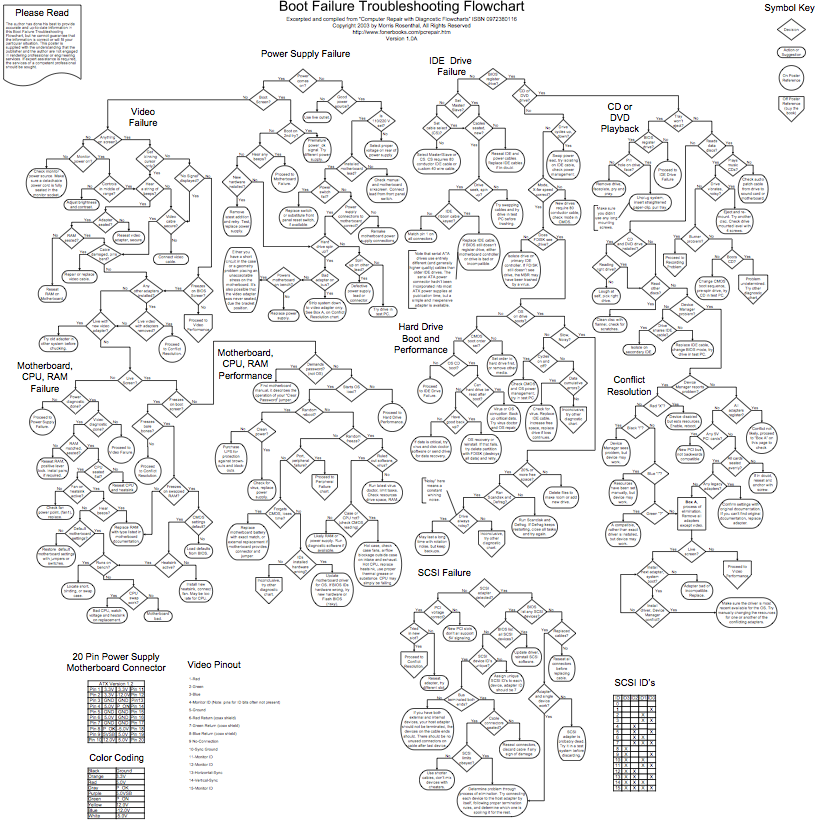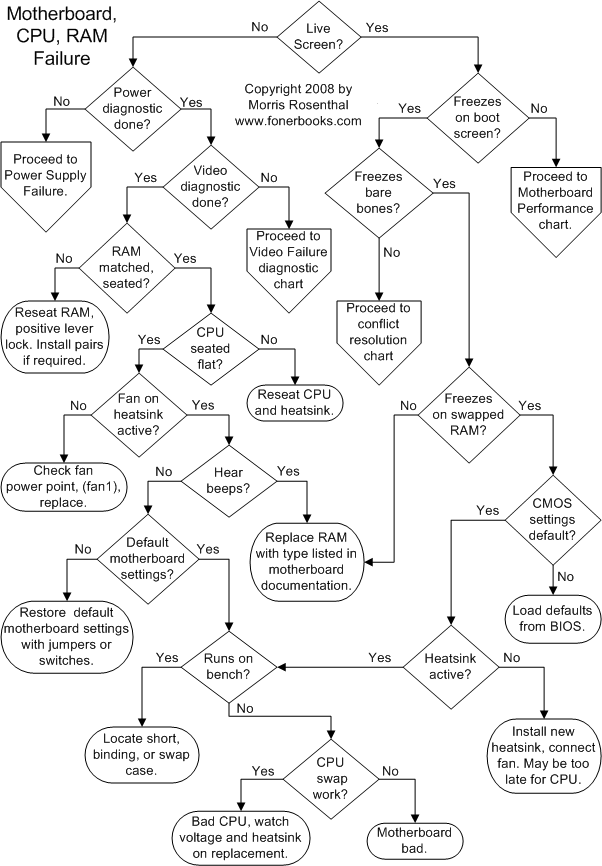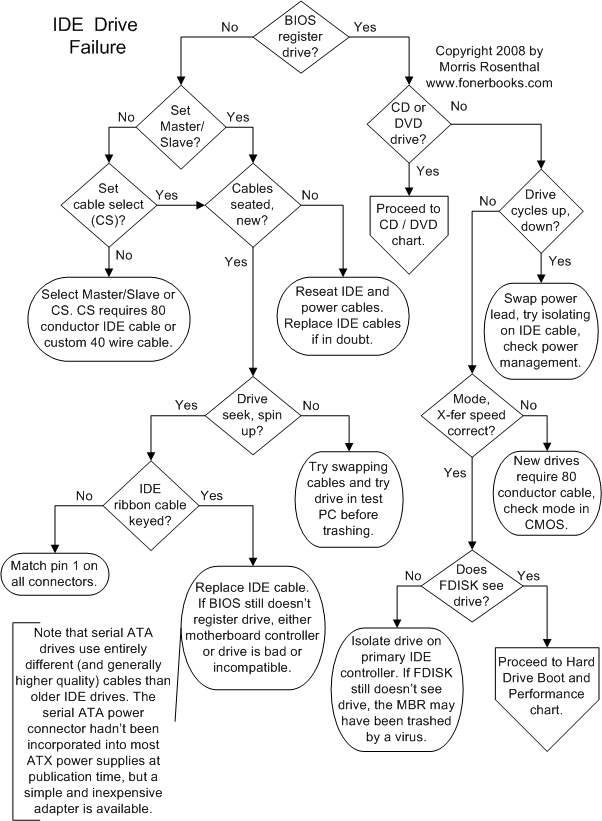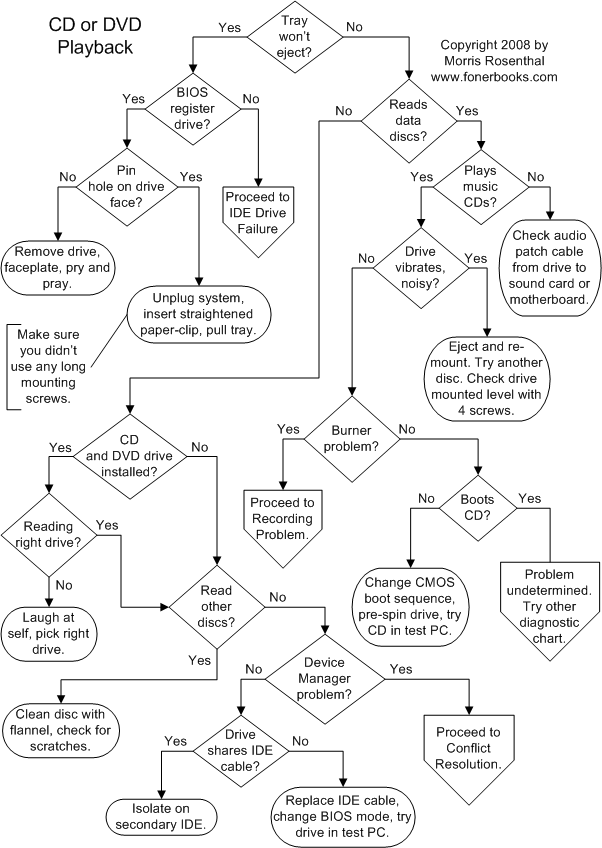Sept 5 2009 UPDATE TO POST: The author of these flowcharts, Morris Rosenthal, expressed concern about having his copyrighted material shown here. Therefore the links from the thumbnail images below were removed. Please see his Computer Repair with Diagnostic Flowcharts site for the full examples of his flowcharts or purchase his Computer Repair with Diagnostic Flowcharts book from Amazon.
—————–
Many DC area consultants use flowcharts and work flows in their jobs. If you’re interested in following the diagnostic process of computer repair specialists, take a look at these flowcharts by Morris Rosenthal. They illustrate many of my thought processes when fixing a computer problem.
Boot Failure Troubleshooting
 The most comprehensive of these flowcharts is the Boot Failure Troubleshooting Flowchart which encompasses several smaller flowcharts. You can see that it is PC focused, asking you to run scandisk and FDISK on your hard drive. Still, the principles apply to any computer.
The most comprehensive of these flowcharts is the Boot Failure Troubleshooting Flowchart which encompasses several smaller flowcharts. You can see that it is PC focused, asking you to run scandisk and FDISK on your hard drive. Still, the principles apply to any computer.
Many of these troubleshooting repair processes are illustrated individually in an easier to read and print format:
Power Supply Diagnostics
 Power Supplies commonly break, especially if they are hit by a power surge (too much power, such as when hit by lightning), blackout (no power), or brownout (lower voltage power).
Power Supplies commonly break, especially if they are hit by a power surge (too much power, such as when hit by lightning), blackout (no power), or brownout (lower voltage power).
A power supply can die over time (booting occasionally) making it trickier to diagnose. Be sure to get a high enough wattage power supply, especially if you have a power hungry graphics card.
CPU, RAM and Motherboard Troubleshooting
 RAM problems can be vexing because they might only appear when a particular part of the RAM is accessed. This can manifest itself through strange computer behaviors that are often mistaken for viruses.
RAM problems can be vexing because they might only appear when a particular part of the RAM is accessed. This can manifest itself through strange computer behaviors that are often mistaken for viruses.
Motherboards, known as Logic Boards in the Mac world, hold the RAM and CPU. Without replacement parts, it can be difficult to determine where the problem lies between these three components.
Hard Drive Failure
 With spinning disks and moving heads, hard drives will eventually fail. Many of today’s laptop hard drives have accelerometers built-in so that they can protect the hard drive when you are moving the laptop. But the moving parts will eventually break. Studies show annual hard drive failure rates to be 2-13%, depending on usage and particular model used. Over the next 5 years there is expected to be a transition to primarily using solid state drives (SSDs) that can potentially last longer and use less energy.
With spinning disks and moving heads, hard drives will eventually fail. Many of today’s laptop hard drives have accelerometers built-in so that they can protect the hard drive when you are moving the laptop. But the moving parts will eventually break. Studies show annual hard drive failure rates to be 2-13%, depending on usage and particular model used. Over the next 5 years there is expected to be a transition to primarily using solid state drives (SSDs) that can potentially last longer and use less energy.
This flowchart assumes the use of IDE hard drives, which are older than the standard SATA drives in today’s computers.
CD and DVD Troubleshooting
 Again, this chart assumes that you are using an IDE connector, not today’s standard of SATA drives.
Again, this chart assumes that you are using an IDE connector, not today’s standard of SATA drives.
Other steps in drive diagnosis include:
- Listening to the drive. Bad hard drives and CD drives might actually sound bad, with grinding, straining, or clicking noises.
- Looking in the Windows Device Manager for driver issues. These may be fixed with new drivers, or might (for older IDE drives) require you to remove or change the setup of other devices.

Video Card Diagnostics
These video card diagnostics assume that you are using a discrete video card, not a motherboard with integrated video which are common in today’s lower cost computers.
Network Troubleshooting
 This is another case where it is useful to have other computers available to determine if the problem is related to the network (cables, router, switch) or the computer.
This is another case where it is useful to have other computers available to determine if the problem is related to the network (cables, router, switch) or the computer.
Fixing Computers
These and other flowcharts are in Morris Rosenthal’s book:
Computer Repair with Diagnostic Flowcharts Revised Edition: Troubleshooting PC Hardware Problems from Boot Failure to Poor Performance
These flowcharts can give helpful hints to fixing computer problems. Unfortunately, they can’t cover all the latest technologies as they come out.
A couple of things that I do to diagnose and repair computers include:
- Testing with replacement parts. If the monitor doesn’t show video, you can hook up another monitor with another video cable to see if it’s the computer or monitor that is malfunctioning. If you suspect a bad power supply, you can try a working one.
- Perform a quick Google search. New computers often ship with a driver problem or needed updates that are easily fixed by searching Google or the knowledge database of the computer manufacturer.

Thank you for putting this on the interwebs now i can show people why it is not an easy job fix ing computers
thank you for taking the time to put this material on the web. The flowcharts will be a valuable addition to my repair books.
I’ll echo the statements above. Pretty cool stuff.
You can always solve the problem by getting a Mac instead ;-P
But you still can’t right click.
Spend about a thousand more for something that makes you smug.
or spend at least 500 on a linux based setup that cleans the smug in the air.
@Drew
Yeah, because Macs don’t use hardware?!
Nice! If I’m not mistaken, this is the chart used by our tech support team in our institution.
They remind me very much of the fantastic IBM Field Engineer handbooks from the late 70’s. Every mainframe operator worth his saalt had bribed his local CE (customer engineer) for a copy. With that book and the field repair kit (6 large red trunks containing every card from the machine in question), you would be almost guaranteed to fix whatever the problem was – eventually, just by following the incredibly detailed flowcharts that covered page after page.
Great summary. Wow!